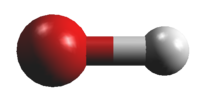Hydroxide ion, deuterium isotopic species, X 1Σ+
 | |
|---|---|
| Species tag | 018502 |
| Version | 1* |
| Date of Entry | Dec. 2006 |
| Contributor | H. S. P. Müller |
|
The fit combines pure rotational as well as rovibrational
data of three isotopic species.
The OH– rotational data were taken
from | |
| Lines Listed | 22 |
| Frequency / GHz | < 12478 |
| Max. J | 22 |
| log STR0 | -10.0 |
| log STR1 | -10.0 |
| Isotope Corr. | -3.941 |
| Egy / (cm-1) | 0.0 |
| µa / D | 1.04 |
| µb / D | |
| µc / D | |
| A / MHz | |
| B / MHz | 299331.6 |
| C / MHz | |
| Q(1000.) | 72.1580 |
| Q(500.0) | 35.2959 |
| Q(300.0) | 21.2687 |
| Q(225.0) | 16.0275 |
| Q(150.0) | 10.7936 |
| Q(75.00) | 5.5704 |
| Q(37.50) | 2.9721 |
| Q(18.75) | 1.6994 |
| Q(9.375) | 1.1406 |
| detected in ISM/CSM | no |